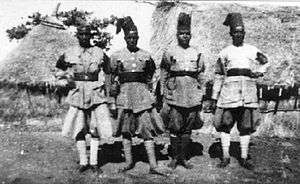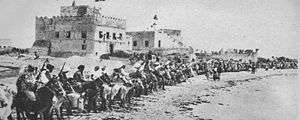Zaptié

Zaptié was the designation given to locally raised gendarmerie units in the Italian colonies of Tripolitania, Cyrenaica, Eritrea and Italian Somaliland between 1889 and 1942.
Origins and duties
The word "zaptié" is derived from the Turkish zapiteh; a term which was used to refer to both the Ottoman Empire's gendarmerie prior to 1923, and to the Turkish personnel recruited for the Cyprus Military Police during the period of British rule on the island.
The Italian colonial governments in the territories listed above modelled the various zaptié constabulary forces on Italy's own carabinieri. The first of these units was raised in Eritrea in 1882, drawing from existing companies of basci bazuks (irregular troops).
In Tripolitania and Cyrenaica the zaptié were generally used for patrolling rural areas in coastal regions, while mounted police or spahis operated in the southern desert regions, together with camel mounted meharists. In the city of Tripoli civilian police were employed. The original Libyan zaptié were recruited from indigenous gendarmerie of the same name, who had served under the Turkish government prior to 1910.
In Italian Somaliland, the zaptié provided a ceremonial escort for the Italian Viceroy (Governor) as well as the territorial police. There were nearly one thousand such para-military police in 1922, when Benito Mussolini took control of the Italian government and started a policy of "pacification" and assimilation of the Italian colonies.
Attire, weaponry and ranks
Zaptié troopers were armed with 1874 model revolvers, cavalry carbines, and 1871 model sabres. Officers and some non-commissioned officers were Italian, but the rank and file were recruited from the colony in question. As an example, the Somali Zaptié Corps in 1927 numbered 1,500 Somali and 72 Italian personnel. Uniforms varied from colony to colony, but usually comprised fezes, red sashes and khaki or white clothing. A common feature was the white and red collar insignia of the carabinieri.
Campaigns

Three hundred zaptié took part in the Italian conquest of northern Somalia in 1925. As part of the "colonna Musso", they assisted in the occupation of the Sultanate of Hobyo (Hafun and Ordio). Other zaptìé units served with the "colonna Bergesio" in the Elemari region (Gallacaio, Garad and Sinedogò). In 1926, zaptìé served in the Majeerteen Sultanate (Bender Ziada, Candala and Bender Cassim).[1]
Zaptìé detachments participated in the Italian conquest of Ethiopia in 1936 and in the East African Campaign of World War II.
In 1941 in Somalia and Ethiopia 2,186 zaptìé (plus 500 recruits under training) formed part of the Carabinieri. They were organised in a battalion commanded by Major Alfredo Serranti that fought at the Battle of Culqualber in Ethiopia for three months until this military unit was destroyed by the Allies. After heavy fighting the Italian Carabinieri received "full military honors" from the British.[2]
In this battle, Muntaz (corporal) Unatù Endisciau of the LXXII Zaptié (I° Gruppo Carabinieri) Battalion was the only "soldier of colour" to be awarded the Italian Gold Medal of Military Valor.[3]
After World War II, a former member of the zaptìé corps, Siad Barre, became President of Somalia from 1969 to 1991.[4]
See also
Notes
- ↑ Italian conquest of north-eastern Somalia Archived February 6, 2012, at the Wayback Machine.
- ↑ "Non tutti sanno che... Zaptié" (in Italian)
- ↑ Article of Arnaldo Grilli on the first two years of World War II (in Italian).
- ↑ President Siad Barre life (German) Archived July 27, 2011, at the Wayback Machine.
References
- "Le Uniformi dell" AOI (Somalia 1889-1941)" Piero Crociani and Andrea Viotti.

